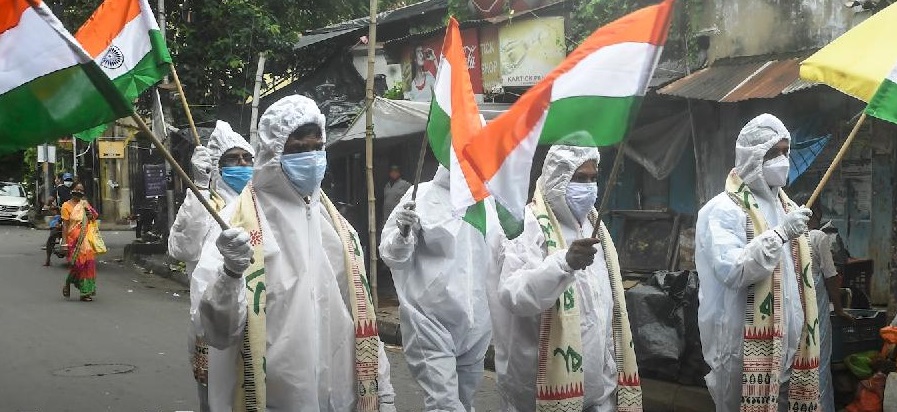As India celebrates 73 years of independence, India is facing two unprecedented challenges. Battling a dreaded pandemic Corona and an incursion attempt by PLA at Ladakh region. Corona pandemic is a global catastrophe which has affected more than 2 crores 10 lakh people so far and has crippled the economy of rich and poor nations. With regards to the stand-off at the LCA in Ladakh, there is no co-participant and India needs to deal with an ambitious rogue nation who wants to control the world. So far, India had a testing time in the year 2020. The current crisis is a litmus test to the unity of our nation.
Despite our best efforts, Corona infection is still on the rise and it is spreading as a community infection. Though the casualty rate of India is not high, we cannot take the pandemic lightly. Only people’s participation and medical intervention can plug the spread of this pandemic.
It is also very important for India to expedite the vaccines under development. Though the trials are underway, only when they are commercially available, people will feel confident to resume their normal life. Multiple containment zones in economic hubs are impacting our economy adversely.
Key Priorities to Turn around the Economy
Early introduction of an indigenous vaccine for Corona under the aegis of ICMR is the numero uno challenge. The stand-off with China has adversely affected the import of Chinese goods to India. Many items like electrical machinery, cell phones, heavy machinery, telecom, power, plastic toys, critical pharma ingredients, furniture, pharma, fertiliser, food, and textiles are on the list. In the absence of access to technology, funds and skilled labourers, India will not be able to manufacture the substitutes for Chinese imports immediately. Government of India (GoI) must roll out a plan for indigenous manufacturing in a time-bound manner. For emergent requirement, we must find alternative sources other than China.
Make in India or ‘Atma Nirbhar Bharat’ can happen only when all our resources are synergised. Current policies should evolve to shift the manufacturing bases from China to India. India must now focus on developing indigenous technologies. Few disruptive technologies which India could make an impact over the world are 5G, unmanned aircraft, high altitude long endurance drones, scramjet, ramjet propulsion, Artificial Intelligence, Blockchain, Virtual Reality and Augmented Reality.
Internet of Things (IoT) can transform our cities into “smart cities” which are more efficient, cost-effective, and safer places to live. Energy-efficient smart buildings, smart lights, smart infrastructure (which will detect faults or deterioration in city infrastructure or contamination in water supplies), smart grids for efficient energy distribution, driverless cars with AI-enabled mobility and navigation system, etc could be augmented in a phased manner in selective cities and towns.
Renewable energy should be the choice for all energy needs. Electricity generation using sunlight, wind and tidal wave should replace the current hydel, coal and diesel. This attempt could reduce our carbon footprint.
We have made great strides in developing weapons and weapon delivery platforms so far. Dhanush Howitzer, Nag Anti-Tank Missile, Piniaka Multi Barrel Rocket Launcher, Aakash MRSAM, Tejas Light Combat Aircraft, Advanced Light Helicopter, Light Combat Helicopter, Arjun Main Battle Tank, Radar Imaging Satellite, Ballistic Missile Defence Shield comprising of Prithivi Air Defence and Advanced Air Defence missiles, Kilo Ampere Linear Injector (KALI) Directed Energy Weapon and Anti-satellite (ASAT) are the few in our armoury. However, some defence platforms like fighter aircraft, attack helicopters with Beyond Visual Range (BVR), Precision-Guided Munition (PGM) and basic assault rifles are being imported. More than seven decades of R&D, our leading DRDOs and Defence PSUs found wanting in developing and manufacturing defence equipment aided with strategic technologies.
Self-reliance in the development of defence equipment in India through the transfer of technology (ToT) and indigenous efforts may be given priority. Both DRDOs and Defence PSUs to open up and collaborate with academia and industry. It is essentially the lack of enforcement by the Government agencies which resulted in a lethargic indigenous production. Under ‘Make in India’ and ‘Atma Nirbhar Bharat’, DRDOs and Defence PSUs should be made more accountable.
GoI has shown strong resolve in removing many hurdles paving the way for faster economic growth. Demonetisation, GST, PM Jan Dhan account, road infrastructure in the inaccessible areas, rural electrification, the supply of free cooking gas, opening of SEZs and aerospace and defence industrial corridors and ease of doing businesses etc have helped the country to move ahead. The focus now should be towards an increase in agriculture production and taking this share to 30% of the economy. Opening more SEZs and industrial corridors in states and UTs can help the economy. Hassle-free funding to entrepreneurs can be instituted. Nationalised banks must set aside a percentage of fund for MSMEs. The distribution of production between private and public companies should be done to give advantage to industrially backward states.
There is a need to increase the revenue for the GoI post COVID period. While GST collection got flattened, bringing more population under the Income Tax bracket can be prudent exercise. IT assessment could be made based on income as well as expenditure. There are many rich people who are outside the Income Tax bracket. A bottom-up approach would trace and reveal these tax evaders. Currently, the GoI is harnessing around one lakh crore GST revenue per month. The GST tax collection has come down drastically view pandemic. The GST revenue can be increased only by bringing in the shops and establishment who are shying away from GST payment.
“India in its 74th year of independence needs to set goals to become a self-reliant nation and work relentlessly towards achieving the goal as a shared vision by taking our economy to USD 5 trillion by 2025 despite the challenges we are currently facing”
Image Courtesy :https://newsus.cgtn.com/news/2020-
Disclaimer: The views and opinions expressed by the author do not necessarily reflect the views of the Government of India and Defence Research and Studies








